An Ortega/Holloway Comparison
by Steve McGill
Two of the best 110 meter high hurdlers in the world right now are America’s Grant Holloway and Spain’s (via Cuba) Orlando Ortega. Last month, I wrote an article on Holloway acknowledging his rise to the top of the event and explaining the many things he does well and the few things he can improve upon. Meanwhile, although I wouldn’t say by any means that Ortega is “better” than Holloway, I would say that I like his technique more, and that Ortega is on the very short list (along with Allen Johnson and Liu Xiang) of hurdlers I would instruct my male hurdlers to study. In this article, I want to compare the hurdling styles of Holloway and Ortega so that you can see what I’m talking about in regards to the things Holloway can improve upon. To do so, I will be analyzing a few photos and also looking at video footage of a race from August of 2020.
[am4show not_have=’g5;’]
[/am4show][am4guest]
[/am4guest][am4show have=’g5;’]
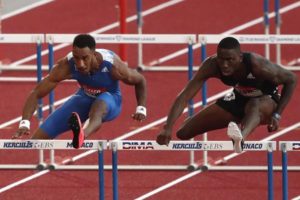
In this photo, Holloway and Ortega are at virtually the exact same point in hurdle clearance. And their forms look almost identical. Both are maintaining a good forward lean from the waist, keeping their chin up and keeping their eyes looking forward. Both are maintaining a tight arm action, with the lead arm punching down and the trail arm beside the hip. Both lead legs are slightly bent at the knee, creating a slight downhill angle. Both trail legs are beginning to drive to the front. But if you look closely, you’ll see an important difference in their trail legs. From the angle of the photo, you can’t see the foot of Ortega’s trail leg at all; that’s because it’s tucked beneath the hamstring, which will enable the knee to lead the way. With the lead and the trail leg, we always want the knee to lead the way. In the case of Holloway, you can see his foot. Why is that? Because his heel is not tucked under his hamstring. It’s getting away from him a little bit, which means two things: 1) The path of the trail leg will be wider than Ortega’s, and 2) the knee of the trail leg will point down for an instant, meaning he will need to raise it up while bringing it forward. That can cause an opening of the hip on the trail leg side, which can lead to twisting the hips later in the race, which sometimes happens with Holloway.
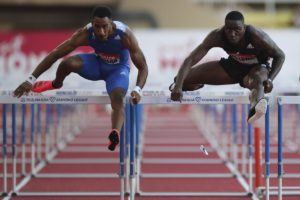
In this photo, both Ortega and Holloway are descending off the hurdle, but Ortega is ahead by just a smidgen. Still, you can see that although both exhibit a tight hurdling action, Ortega’s trail leg is tighter and higher, which is what I always teach my athletes to do. The higher, tighter action ensures that the trail leg knee will be facing the front when the foot of the lead leg lands, leading to a faster get-away off the hurdle.
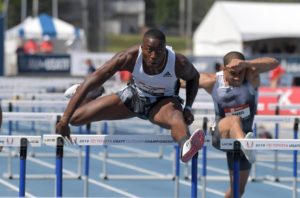 This photo is from 2019, pre-pandemic, and Holloway’s form wasn’t as good then as it is now. But it’s a good photo to show how his wide trail leg can potentially create trouble. At this point in hurdle clearance, his trail leg knee should be coming up under his armpit, but instead the knee is facing down and the foot is kicking back, putting a strain on the groin. This photo is from late in the race, so it shows how, over the course of a race, his tendency to let the heel of the trail leg get away from him can cause balance issues in a race’s later stages.
This photo is from 2019, pre-pandemic, and Holloway’s form wasn’t as good then as it is now. But it’s a good photo to show how his wide trail leg can potentially create trouble. At this point in hurdle clearance, his trail leg knee should be coming up under his armpit, but instead the knee is facing down and the foot is kicking back, putting a strain on the groin. This photo is from late in the race, so it shows how, over the course of a race, his tendency to let the heel of the trail leg get away from him can cause balance issues in a race’s later stages.
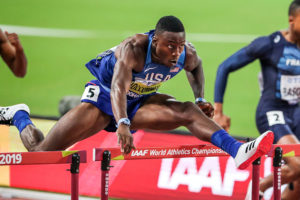
This photo shows the same issue discussed in the previous photo. The trail leg knee pointing down like that is bound to cause problems late in the race, when fatigue sets in and it becomes more difficult to rely on speed and strength to mask the mistake.
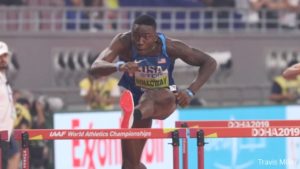
In this photo, take a look at Holloway’s lead arm. Even though his lead arm never swings across his body, it does tend to move in a left-to-right motion, as it seems to be doing here. If it’s moving left-to-right during take-off, even slightly, then it will inevitably move right-to-left during descent. That side-to-side action will inevitably cause the trail leg to widen. So, the flaw we are seeing in all of these photos with the trail widening is most likely being caused by that slight side-to-side motion with the lead arm. Over a five-hurdle indoor race it absolutely does not matter. But in a ten-hurdle outdoor race it can create problems, and it has at times.
In the video above, from a Diamond League race in 2020, Ortega and Holloway are side by side, giving us a good view of their respective techniques. Take a look at the race and hone in on their lead arm actions and their trail leg actions. You will notice that Ortega’s lead arm moves in an up-and-down motion and that his hips, consequently, stay square, and his trail leg comes through high and tight. Holloway, meanwhile, has that slight left-to-right motion with the lead arm, causing the trail leg hip to open up a bit, widening the path of the trail leg. So, even though Holloway’s trail leg looks to be the problem, the lead arm is actually the source of the problem. Fix the lead arm and the trail leg will fix itself. In this race, Holloway blasts everybody out of the blocks, including Ortega, yet he fades later in the race and is caught by Ortega, and by two other hurdlers as well. In the replay that begins at the 3:44 mark, you can clearly see Holloway’s lead arm action with the slight side-to-side motion, and you can see that his trail leg gets wider and lags more and more behind as the race goes on. This is a very minor issue but it will always be a major factor when running against the world’s best. Hurdlers like Ortega will always know that if they stay close to Holloway early, they will have a chance to catch him late.
[/am4show]
